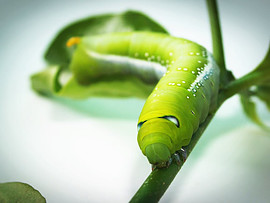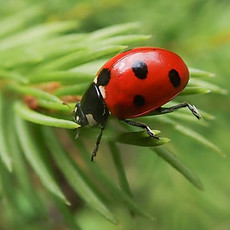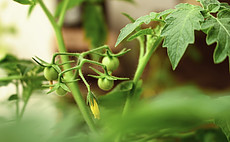
When a plant gets infected, this is one of the most terrible things that can happen in your garden. You’ll begin to ask yourself a series of questions. How did it occur? Is it going to spread? Will other plants get infected? How will I control it? The disease triangle is the most crucial thing to understand about the prevention of diseases. In this post, you’ll learn how to keep your garden healthy.
Plants only get infected upon the coincidence of three things: you grew a plant that has a tendency to get ill (a host); some pathogens (such as viruses, bacteria, or fungi) that can harm the plant; and some climatic conditions (such as drought or humidity) that boost the disease.
With the absence of these three things, no disease will ever happen; so to knock out one side of the triangle or more, you need preventive measures. Prior to experiencing problems in your garden, try your best measures to prevent plants from getting sick. Here are 7 ways to remove one or more side of the disease triangle and keep your garden healthy.
1. Perform a Thorough Examination on Plants Prior to Purchasing
The best way to eliminate diseases in your garden is to ensure that you don’t attract them in the first place. Seeing a fresh plant get infected isn’t everybody’s expectation. One of the most difficult things to master is how a healthy plant should look, making it hard to identify which one is infected, and which is not.
It’s a brilliant idea to gather a few catalogs, magazines, and books which analyze how a healthy specimen should look. Avoid taking home plants with insects, rotted stems, or dead spots. Such plants can easily infect your healthy plants and can, most times, be difficult to control once penetrated.
Aside from examining the plant tops, ensure you always check the quality of the root. Though customers don’t usually do this in the center of a garden, it ought to be a constant sight. Place your fingers on the surface of the soil and position the stem of the plant between your fingers.
Tap the pot’s edge against a hard surface in order to loosen those roots. Roots must be white, firm, and spaced around the root ball. Mushy or dark roots are a bad sign. In no time, a rotted, bad root destroys a plant, even when the tops look healthy.
2. Explore Composted Yard Waste
Materials in a compost pile don’t get decomposed at a constant rate. Some materials may have lost too much value to be placed in the garden, whereas others may still remain intact. Ideal composting leads to high temperatures for a prolonged period of time, which literally results in the death of the pathogens in the material.
Sick plant debris that hasn’t gone through this stage will transfer some diseases into a garden. If you doubt the condition of your compost pile, don’t hesitate to stop exploring yard waste and never add potential sick debris to your pile.
3. Keep a Close Watch on Your Bugs

Bacteria and viruses can only infect a plant via some kind of opening, and bug infection provides this. There are insects that transport viruses, getting plants infected. One of the widely-known carriers is Aphids, and impatiens necrotic spot viruses are spread by thrips, which were a critical challenge for commercial producers for the past decade.
The virus that carries the disease Aster Yellows is called leafhoppers and this disease has a myriad of host plants. One of the ways to put plants in a distress is through insect attacks.
4. Sanitize in the fall
It’s normal practice to sanitize your garden within the fall, no matter how moderate the climate you live in is. This will not only prevent diseases around your garden but also serve as a deterrent to infections.
Overwintering can happen on debris and dead leaves, which could infect the fresh leaves as they grow up in spring. Examples of diseases that can be drastically controlled if the dead plants are removed in the fall are a black spot on roses, daylily leaf streak, and Iris leaf spot.
5. Use the Fertilizer Correctly
To avoid too much of your fertilizer burning roots and failing to absorb water when using the fertilizer for plants, you need to take caution. With this, the plants will become more susceptible to get stressed from heat, cold, and drought.
When plants are starving for essential nutrients, they tend to reduce in size and can be negatively influenced by leaf spots, whereas a more rugged plant can kill diseases. Too much of a specific nutrient is a cool way to put a plant in a distress.
If you can get a soil test via your local extension agency, you’ll be provided with accurate data on the levels of nutrients in your soil. Otherwise, you’ll have some guesswork on your own part trying to feed your plants, and this may lead to having not enough water or having an excess of one nutrient.
6. Plant Disease-resistant Varieties
Some disease-resistant plants might get infected with a specific disease but will dispute the disease rather than responding to it. For example, some plant (tomato) varieties are resistant to the fungi VFN (Verticillium, Fusarium, and Nematodes).
If you’re searching for the VFN on flowers, you will likely get shocked because disease resistance is uncommonly figured-out on plant tags. It does not imply that several varieties of flowers are disease-resistant. Most rose firms provide plants that are resistant to diseases such as back spot, powdery mildew, etc.
Nursery workers and co-gardeners can help you figure out the best resistant varieties of numerous plants. Reference catalogs and publications may also shortlist varieties and plants that are resistant to specific diseases.
7. Water Adequately
Watering a garden is a great practice. You determine when it comes to making a difference between the number of diseases and plants that need water. Numerous pathogens in the air and soil require lots of water to grow, move, and produce again.
To provide diseases with unfavorable weather, select watering models that reduce the moisture on the foliage of a plant. Drip irrigation and soaker hoses help to achieve this. If you’re using your hand to water, put the leaves aside as you water those roots.
When leaves are wet, the most usual leaf challenges are exacerbated. Thus, the least preferred alternative is overhead sprinkling. If you select this model, start watering when you see the leaves run dry so quickly but there is enough time for roots to absorb moisture prior to evaporating.
I hope you enjoyed reading these articles and if you have any questions or something to share about these articles, please leave your comments below and I’ll happy to get back to you.
Thank you so much and happy gardening.

natasa1234
I have a small garden on the terrace that I have been trying to maintain for some time, but every time I fail. Every time my plants die for a reason unknown to me which has led me to discouragement. Your post has given me the necessary knowledge on how to make and maintain the most beautiful garden. Thank you very much.
admin
Hi Natasa,
Thank you so much for dropping by and reading about my articles. It’s nice to know that you have a little garden to manage in your home. Yes, I understand your experiences in your garden, sometime plants just die for many reasons. But If, you’re going to put much time, attention and care they are there greenie and happy, and your also happy harvesting your fresh veggies for your table. Thank you so much, best wishes to you and to all your family.
Joyce
Parameter
Purchasing an healthy plant is very important when buying your seedling. This many people do not consider. They buy seedlings blindly, like you rightly mentioned your environment is another point of investation. I grow mangoes on a commercial basis. The moment you watch out for this things you are on your way to a healthy plant
admin
Hi Parameter,
Thank you so much for dropping by and reading my articles about ways to keep your garden healthy. Yes, your right selecting of seedlings for your area is a very important aspect of gardening. It needs they suit the soil and also the climate in your place. Thank you and Good luck!
Joyce
israel Olatunji
Thanks for the tips on keeping a garden healthy, Josephine! I never knew the use of fertilizer could effectively ensure the health of a garden, even though it’s useful for boosting a plant from the nursery. I’ve heard a lot of people say negative words about the use of fertilizer for plants. Some believed it contains chemicals that are harmful to humanity. Is that true? I’d also like to apply adequate watering of the garden. I hope this will work for me effectively!
admin
Hello, Israel!
Thank you so much for dropping by and reading my articles about the 7 Ways to Keep Your Garden Healthy. Yes, you’re right. Some people are talking negatively about fertilizer use to their plants, but I believe they are few, and some really want to give good fertilizer to their plants. Because if without fertilizer, soils are not as productive, and crops do not grow.
Yes, it is also true some chemicals are harmful to humans. Plants fertilizer can poison people and pets if they are inhaled or accidentally ingested. But there are fertilizers that environmentally friendly even to humans and pets.
Thank you so much for your visit. Come again!
All the best,
Joyce
Igwubor 1
My father was a gardener and we always helped him out in his garden. So i found this very interesting to read and coming across your articles really makes me feel nice. I also learned new methods in keeping a garden healthy so I shared this article with my dad and I know he would definitely love it as well
admin
Hello Igwubor.
Great to meet you here. And welcome to my website, and thank you for your interest in reading my articles about the 7 Ways to Keep Your Garden Healthy. It is great that these articles really helps, and you even want to share them with your farmer’s father. Wow, that’s so great.
Best wishes,
Joyce
Andy
We’ve had some great years in our garden and then some really bad years when everything was having trouble. Last year our lawn did really well, but then most of the years previously, we had weeds all over the lawn. In contrast last year our vegetable garden did very poorly whereas for the two previous years we had bumper harvests. I am quite sure we have often had black streaks on the leaves of many plants and grubs on the lawn. One very noticeable change over the years is that many parts of our garden have become a lot more buggy than they used to be. It can be so bad you just don’t want to go there anymore. I am quite sure that one or more of the triangle sides you describe must be out of kilter most if not all the time. You have given us a great deal to think about. Thanks, Andy
admin
Hello, Andy
Thank you for visiting my site.About seven to keep your garden healthy.
Thank you so much,
Joyce